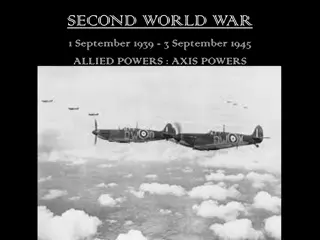World War II: Events and Strategies
World War II saw significant events unfold, from Hitler's invasions to Japan's attacks on Pearl Harbor, leading to the United States fully engaging in the global conflict. Strategies such as island hopping in the Pacific and the Defeat Hitler First approach in Europe were pivotal in shaping the outcome of the war.
Download Presentation

Please find below an Image/Link to download the presentation.
The content on the website is provided AS IS for your information and personal use only. It may not be sold, licensed, or shared on other websites without obtaining consent from the author.If you encounter any issues during the download, it is possible that the publisher has removed the file from their server.
You are allowed to download the files provided on this website for personal or commercial use, subject to the condition that they are used lawfully. All files are the property of their respective owners.
The content on the website is provided AS IS for your information and personal use only. It may not be sold, licensed, or shared on other websites without obtaining consent from the author.
E N D
Presentation Transcript
Unit 8: WWII Chapters 24 & 25
I. War in Europe I. War in Europe World War II began with Hitler s invasion of Poland in 1939, followed shortly after by the Soviet Union s invasion of Poland and the Baltic countries from the east. During the first two years of the war, the United States stayed officially neutral while Germany overran France and most of Europe and pounded Britain from the air (the Battle of Britain). In mid- 1941, Hitler turned on his former partner and invaded the Soviet Union.
Despite strong isolationist sentiment at home, the United States increasingly helped Britain. It gave Britain war supplies and old naval warships in return for military bases in Bermuda and the Caribbean. Soon after, the Lend-Lease Act gave the president authority to sell or lend equipment to countries to defend themselves against the Axis powers. Franklin Roosevelt compared it to lending a garden hose to a next-door neighbor whose house is on fire.
II. War in Asia During the 1930s, a militaristic Japan invaded and brutalized Manchuria and China as it sought military and economic domination over Asia. The United States refused to recognize Japanese conquests in Asia and imposed an embargo on exports of oil and steel to Japan. Tensions rose, but both countries negotiated to avoid war.
While negotiating with the United States and without any warning, Japan carried out an air attack on the American naval base at Pearl Harbor, Hawaii, on December 7, 1941. The attack destroyed much of the American Pacific fleet and killed several thousand Americans. Roosevelt called it a date that will live in infamy as he asked Congress to declare war on Japan. After Pearl Harbor, Hitler honored a pact with Japan and declared war on the United States. The debates over isolationism in the United States were over. World War II was now a true world war, and the United States was fully involved.
III. Strategies III. Strategies Allied Strategy America and its allies (Britain, and the Soviet Union after being invaded by Germany) followed a Defeat Hitler First strategy. Most American military resources were targeted for Europe. In the Pacific, American military strategy called for an island hopping campaign, seizing islands closer and closer to Japan and using them as bases for air attacks on Japan, and for cutting off Japanese supplies through submarine warfare against Japanese shipping.
Axis Strategy bombing campaign and submarine warfare before America s industrial and military strength could turn the tide. Following Pearl Harbor, Japan invaded the Philippines and Indonesia and planned to invade both Australia and Hawaii. Its leaders hoped that America would then accept Japanese predominance in Southeast Asia and the Pacific, rather than conduct a bloody and costly war to reverse Japanese gains.
IV. Major Battles & Turning Points IV. Major Battles & Turning Points North Africa El Alamein: German forces threatening to seize Egypt and the Suez Canal were defeated by the British. This defeat prevented Hitler from gaining access to Middle Eastern oil supplies and attacking the Soviet Union from the south.
Europe Stalingrad: Hundreds of thousands of German soldiers were killed or captured in a months-long siege of the Russian city of Stalingrad. This defeat prevented Germany from seizing the Soviet oil fields and turned the tide against Germany in the east. Normandy landings (D-Day): American and Allied troops under Eisenhower landed in German- occupied France on June 6, 1944. Despite intense German opposition and heavy American casualties, the landings succeeded, and the liberation of western Europe from Hitler began.
Pacific Midway: In the Battle of Midway (termed the Miracle at Midway ), American naval forces defeated a much larger Japanese force as it prepared to seize Midway Island. Coming only a few months after Pearl Harbor, a Japanese victory at Midway would have enabled Japan to invade Hawaii. The American victory ended the Japanese threat to Hawaii and began a series of American victories in the island hopping campaign, carrying the war closer and closer to Japan.
Pacific Cont Iwo Jima and Okinawa: The American invasions of the islands of Iwo Jima and Okinawa brought American forces closer than ever to Japan, but both invasions cost thousands of American lives and even more Japanese lives, as Japanese soldiers fought fiercely over every square inch of the islands and Japanese soldiers and civilians committed suicide rather than surrender. Use of the atomic bomb: Facing the prospect of horrendous American and Japanese casualties if American forces were to invade Japan itself, President Harry Truman ordered the use of atomic bombs on the Japanese cities of Hiroshima and Nagasaki to force the Japanese to surrender. Tens of thousands of people were killed in both cities. Shortly after the bombs were used, the Japanese leaders surrendered, avoiding the need for American forces to invade Japan.
V. Minorities V. Minorities African Americans generally served in segregated military units and were assigned to noncombat roles but demanded the right to serve in combat rather than support roles. Tuskegee Airmen (African American) served in Europe with distinction. Nisei regiments (Asian American) earned a high number of decorations. Communication codes of the Navajo were used (oral, not written language; impossible for the Japanese to break). Mexican Americans also fought, but in non-segregated units. Minority units suffered high casualties and won numerous unit citations and individual medals for bravery in action.
VI. On The Homefront Economic resources United States government and industry forged a close working relationship to allocate resources effectively. Rationing was used to maintain supply of essential products to the war effort. War bonds and income tax were used for financing the war. Businesses retooled from peacetime to wartime production (e.g., car manufacturing to tank manufacturing).
Human resources More women and minorities entered the labor force. Citizens volunteered in support of the war effort. Military resources The draft (selective service) was used to provide personnel for the military.
Women on the home front during World War II Increasingly participated in the workforce to replace men serving in the military (e.g., Rosie the Riveter) Typically participated in noncombat military roles African Americans on the home front during World War II Migrated to cities in search of jobs in war plants Campaigned for victory in war and equality at home
Japanese Internment Japanese Internment Reasons for internment of Japanese Americans Strong anti-Japanese prejudice on the West Coast False belief that Japanese Americans were aiding the enemy Internment of Japanese Americans Japanese Americans were relocated to internment camps. Internment affected Japanese American populations along the West Coast. The Supreme Court upheld the government s right to act against Japanese Americans living on the West Coast of the United States (Korematsu v. U.S.). A public apology was eventually issued by the United States government, and financial payment was made to survivors.
Media and communications assistance The United States government maintained strict censorship of reporting of the war. Public morale and ad campaigns kept Americans focused on the war effort. The entertainment industry produced movies, plays, and shows that boosted morale and patriotic support for the war effort as well as portrayed the enemy in stereotypical ways.
VII. Prisoner Treatment VII. Prisoner Treatment The Geneva Convention attempted to ensure the humane treatment of prisoners of war by establishing rules to be followed by all nations. The treatment of prisoners of war in the Pacific Theater often reflected the savagery of the fighting there. In the Bataan Death March, American POWs suffered brutal treatment by the Japanese after surrender of the Philippines. Japanese soldiers often committed suicide rather than surrender. The treatment of prisoners of war in Europe more closely followed the ideas of the Geneva Convention.
Holocaust Holocaust genocide: The systematic and purposeful destruction of a racial, political, religious, or cultural group final solution: Germany s decision to exterminate all Jews Affected groups Jews, Poles, Slavs, Gypsies, Undesirables (homosexuals, the mentally ill, political dissidents) Significance In the Nuremberg trials, Nazi leaders and others were convicted of war crimes. The Nuremberg trials emphasized individual responsibility for actions during a war, regardless of orders received. The trials led to increased demand for a Jewish homeland.
VIII. Post-War Outcomes The end of World War II found Soviet forces occupying most of Eastern and Central Europe and the eastern portion of Germany. Germany was partitioned into East and West Germany. West Germany became democratic and resumed self-government after a few years of American, British, and French occupation. East Germany remained under the domination of the Soviet Union and did not adopt democratic institutions.
Following its defeat, Japan was occupied by American forces. It soon adopted a democratic form of government, resumed self-government, and became a strong ally of the United States. Europe lay in ruins, and the United States launched the Marshall Plan, which provided massive financial aid to rebuild European economies and prevent the spread of communism. The United Nations was formed near the end of World War II to create a body for the nations of the world to try to prevent future global wars.























